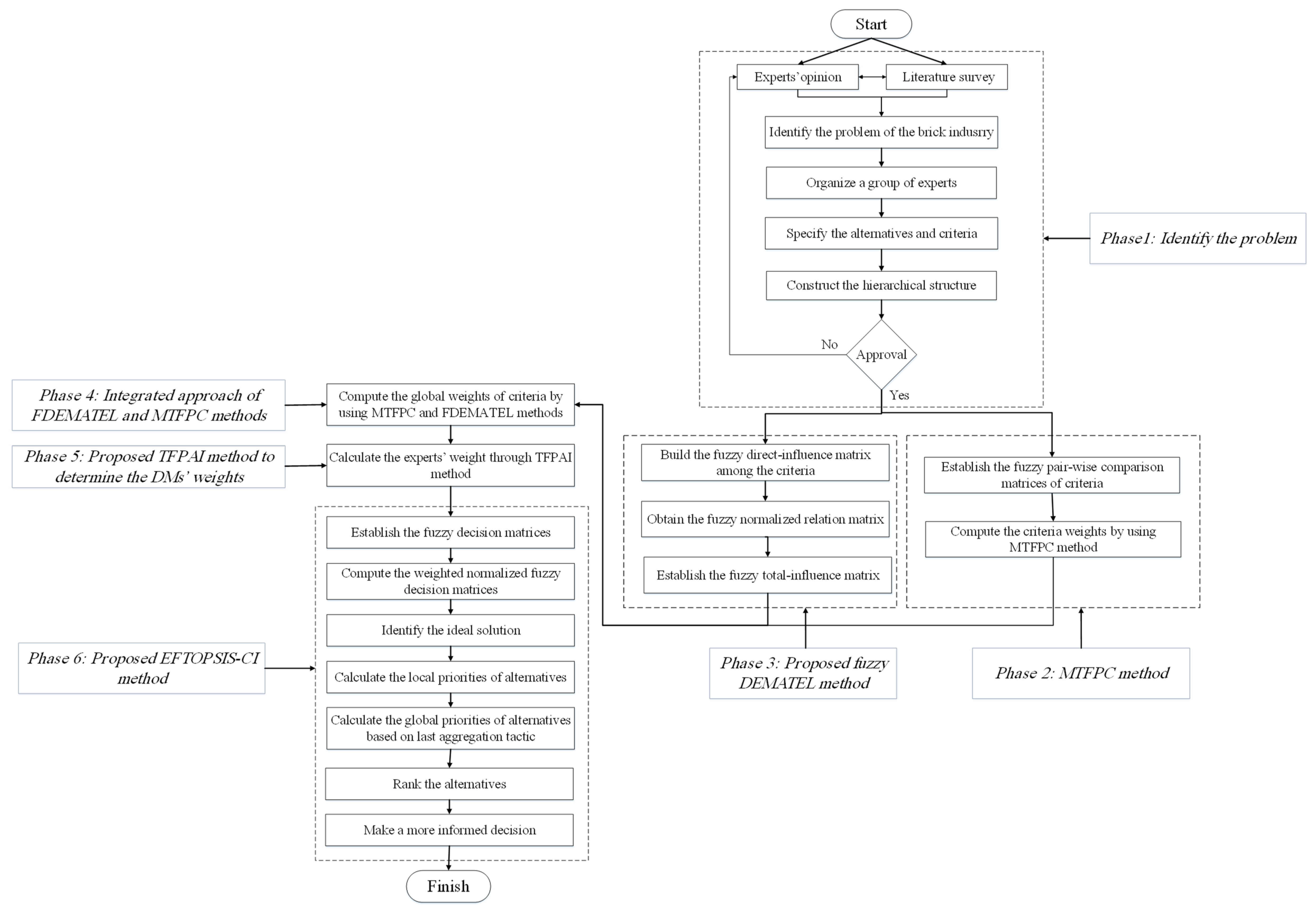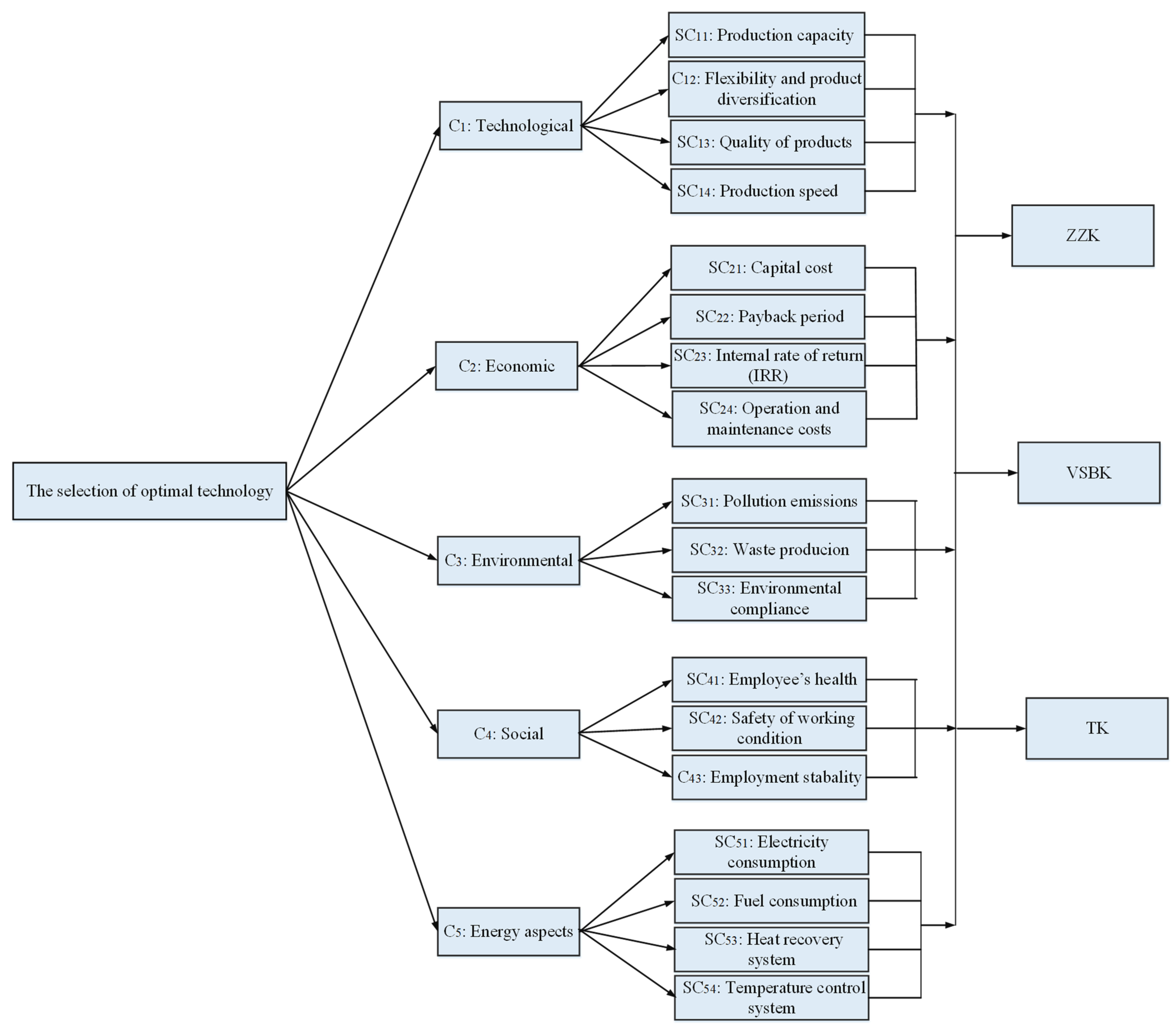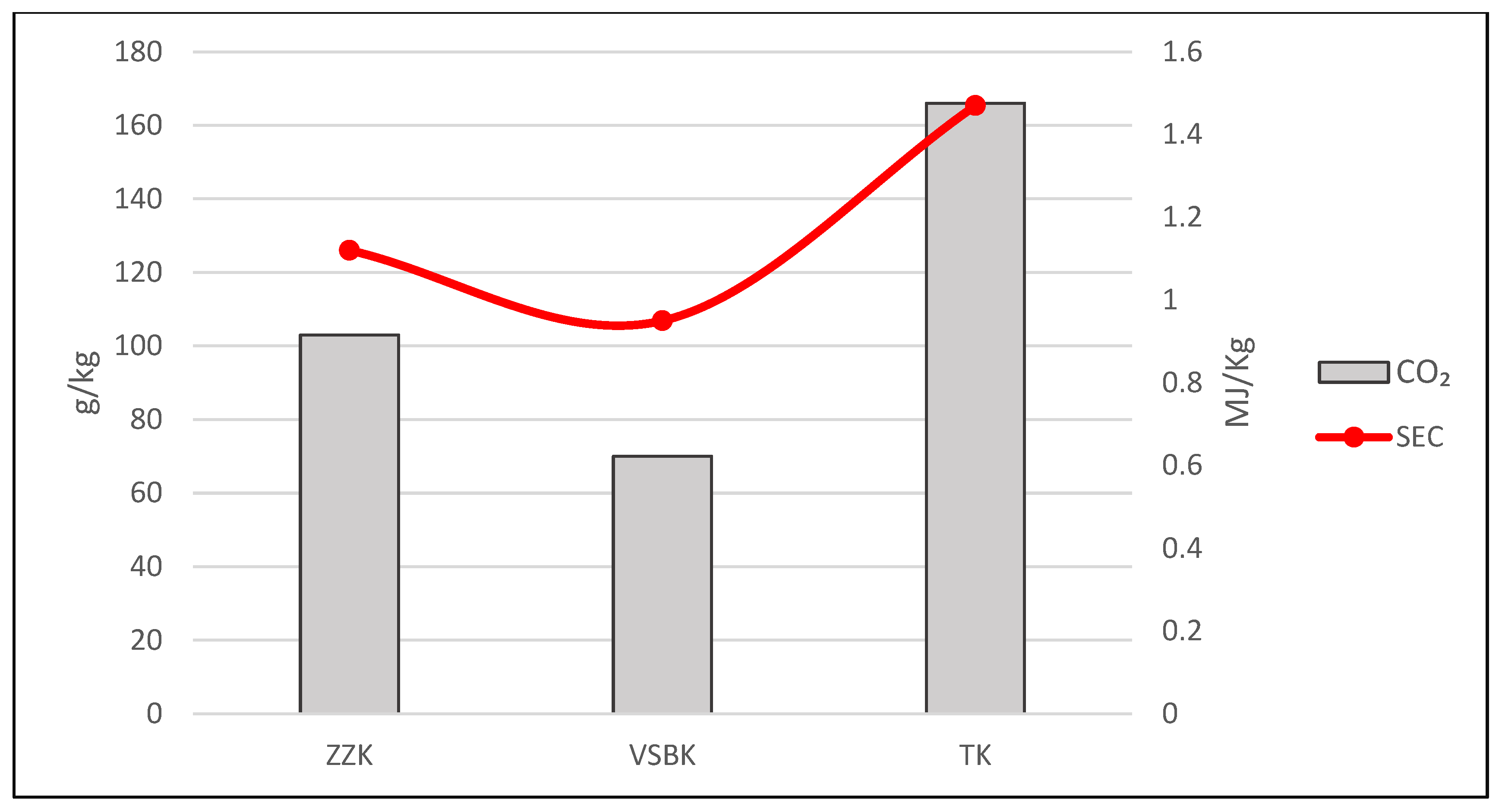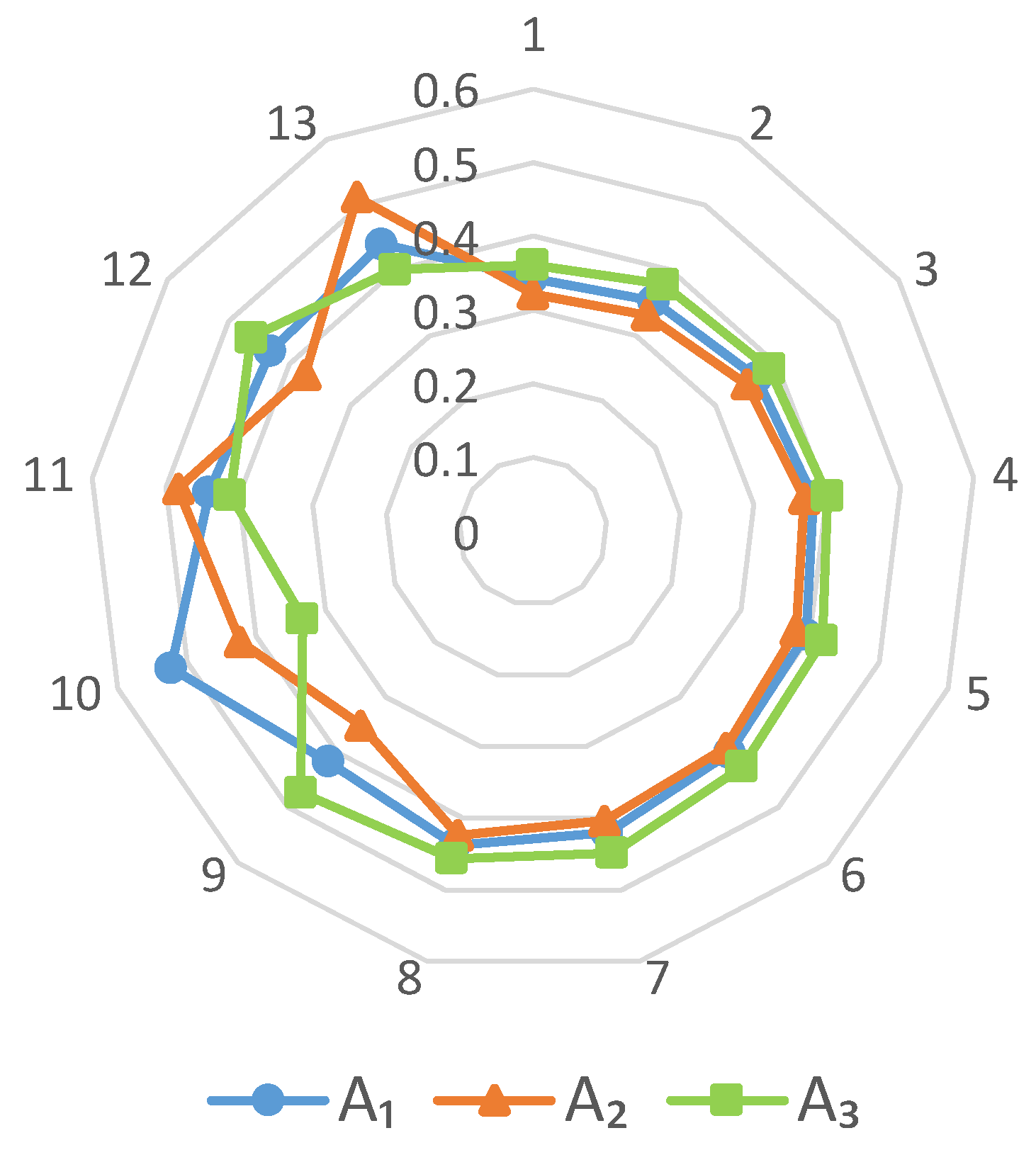2. Proposed a Novel Hybrid Fuzzy MCGDM (HFMCGDM) Approach
This research proposes a new HFMCGDM approach for modeling and solving the technology selection problem. First of all, considering the literature review and experts’ opinions, the possible alternative and viable criteria are determined. Then, the combination of FDEMATEL and MTFPC is applied to identify interrelationships between the criteria and calculate the final weights of the criteria, respectively. Moreover, a triangular fuzzy preference assessment index (TFPAI) method is applied to determine the weight of DMs’ preferences. Afterward, taking the final criteria’s weights and the weights of DMs’ preferences into consideration, and based on the last aggregation tactic, an extended fuzzy TOPSIS collective index method (EFTOPSIS-CI) is presented to evaluate and rank the candidates. The systematic procedures of the proposed methodology are given in
Figure 1. The phases of the proposed method are explained in the following lines.
Phase 1. Identifying the problem: Considering the literature review, field study and interview with experts, the problem was identified. Then, the Delphi method was utilized to determine the assessment criteria and high-tech brick manufacturing candidates. After identifying the viable criteria and alternatives, we sent them back to the experts for approval. Finally, the hierarchical structure is built.
Phase 2. Modified triangular fuzzy pair-wise comparison technique (MTFPC): The analytic hierarchy process (AHP) method is an effective tool for solving MCDM problems; however, conventional AHP does not consider the vagueness and uncertainty of human judgments to model a real situation [
48,
49]. To overcome this problem, a fuzzy AHP method can be a more precise approach. Because Chang’s technique [
50] is relatively easier and less time-consuming compared to other FAHP methods [
51], this paper utilizes Chang’s technique to develop a modified triangular fuzzy pair-wise comparison (MTFPC) technique respecting the last aggregation attitude. The procedures of the proposed MTFPC technique are given as follows:
Step 2.1. Construct pair-wise fuzzy comparison matrices based on experts’ opinions (
) by using the following Equation:
where the
shows a comparison between two criteria
regarding the
k-th expert’s view.
Step 2.2. Compute the fuzzy synthetic extent (
) for the
i-th criterion as follows:
Step 2.3. The possibility degree of
is defined by:
Step 2.4. Considering the
k-th expert, the following Equation is applied for a fuzzy number (
).
where,
. According to the above procedure, the weight vector is acquired as follows:
Step 2.5. Calculate the normalized weight vector (
) as:
Phase 3. Proposed fuzzy DEMATEL technique: The DEMATEL method is considered one of the MCDM techniques to analyze interdependent relationships among all criteria [
52]. However, in real situations, owing to the ambiguity of DMs’ preferences, the crisp data cannot reflect human judgments [
53]. Therefore, fuzzy DEMATEL and MTFPC methods can be integrated to precisely calculate the weights of the criteria. In the ensuing lines, the procedures of FDEMATEL are described:
Step 3.1. Develop the direct-relation fuzzy matrix
and then compute the average matrix. To obtain the influences and connection between criteria
, a team of the DMs
are requested to drawn pair-wise comparisons. In this technique, the cause-effect relationships between criteria are expressed according to linguistic words adopted from [
54]. Subsequently, they translated into fuzzy numbers.
where
shows the degree to which the
k-th decision-maker believes criterion
i affects criterion
j.
Step 3.2. Normalize the direct-relation fuzzy matrix
by applying Equation (8).
Step 3.3. Calculate the fuzzy total-relation matrix
through Equation (9).
where
I is the identity matrix.
Step 3.4. Each fuzzy element of the total-relation matrix
is transformed into crisp numbers (
) by:
Phase 4. Proposed integrated approach of FDEMATEL and MTFPC methods: In this approach, at first, FDEMATEL is used to identify interrelationship among all criteria, and then MTFPC is proposed to measure local weight (
) of the criteria. Consequently, the combination of FDEMATEL and MTFPC methods is proposed to calculate the global weight of criteria as follows:
Phase 5. Triangular fuzzy preference assessment Index method (TFPAI): By considering all experts’ opinions, we can have a more viable assessment. Consequently, a new methodology is developed to measure the weight of each DM by utilizing the mathematical logic of the TOPSIS technique [
55]. The descriptions of the proposed methodology are given as follows:
Step 5.1. Construct the fuzzy decision matrix to evaluate alternative performances based on each expert’s opinion. Thereby,
m alternatives (
Am),
n criteria (
Cn), and a group of experts (
Kk) have been considered.
where
represent the assessment of the
j-th candidate for the
i-th criterion by the
k-th expert.
Step 5.2. Make the normalized fuzzy judgment matrix
by utilizing the Equations (13)–(15).
where
and
represent the cost and benefit criteria.
Step 5.3. Form the weighted normalized fuzzy judgment matrix (
) by:
Step 5.4. Specify the positive (
) and negative (
) optimum solutions as follows:
Step 5.5. Measure the distance of the experts’ preferences from optimum solutions (
) by:
Step 5.6. Measure the experts’ weights
by utilizing the ensuing relations:
Phase 6. Extended fuzzy TOPSIS collective index method (EFTOPSIS-CI): TOPSIS is a multi-criteria methodology to recognize the most appropriate solution among several alternatives [
56]. The uncertainty and ambiguity associated with human preferences make it difficult for the DMs to assign an accurate performance rating to alternatives [
57]. To overcome this difficulty and also avoiding the loss of data, we develop a new Fuzzy TOPSIS method for prioritizing the options according to the last aggregation of the experts’ opinions. The steps of the proposed method are as below:
Step 6.1. Consider the criteria weights obtained from the integration of MTFPC and FDEMATEL as the inputs for TFPAI and EFTOPSIS-CI computations.
Step 6.2. Compute the weighted normalized fuzzy judgment matrix through Equations (13)–(16).
Step 6.3. Obtain the positive (
) and negative (
) optimum solutions by using Equations (23) and (24).
Step 6.4. Determine the distance of alternatives from optimum solutions (
,
) through the following Equations:
Step 6.5. Obtain the local priority for all alternatives (
) with respect to the similarity to the best solution by:
Step 6.6. According to the last aggregation attitude, the global priority of all alternatives (
) is calculated by:
4. Discussion
At first, the detrimental environmental impact and energy usage of brick making has been analyzed. Secondly, the efficacy of the proposed approach is compared with relevant literature. To clarify the effect of criteria’s weight on the final decision, a sensitivity analysis has been conducted; managerial insights are presented for brick production managers. In the ensuing lines, more details and discussions are presented.
4.1. Environmental and Energy Analysis
Table 16 presents the emission factors (EF) and the Specific Energy Consumption (SEC) of different pollutants, measured by Eil et al. [
60]. As shown in
Figure 4. VSBK kiln possesses the lowest EF in terms of carbon dioxide (CO
2), Particulate Matter (PM2.5), and Suspended Particulate Matter (SPM). After that, zig-zag and tunnel kilns take the second and third place, respectively. The zig-zag kiln has the minimum amount of carbon monoxide (CO), followed by VSBK and TK. The TK has the highest concentration of carbon dioxide (CO
2), followed by VSBK and ZZK. By comparing the SEC of mentioned kilns, VSBK has the minimum amount, then zig-zag and tunnel kilns have the lowest values, respectively, meaning that VSBK has the best performance in energy consumption. Looking at the
Figure 5, it can be concluded that there is a direct relationship between energy consumption and carbon dioxide production. In other words, the more SEC is, the more CO
2 will be produced.
4.2. Comparative Analysis
In this section, the proposed method is compared with a method [
39] in recent literature to indicate the efficiency of the proposed method. As demonstrated in
Table 17, the same ranking is obtained in these two methods. The proposed approach has some advantages over the Dinmohammadi and Shafiee [
39] method. First, the fuzzy set theory is utilized and extended to cope with imprecise information and uncertain condition in a real MCDM problem. Secondly, it leads to a more accurate solution by considering the weights of criteria and experts in the problem-solving procedures. Besides, the last aggregation of experts’ opinions is considered to prevent data loss. Likewise, due to a high standard deviation of the proposed approach, it is easier for the DMs to choose an optimal candidate in the MCGDM problem. To summarize,
Table 18 represents the merits of the proposed framework compared to the mentioned method.
4.3. Sensitivity Analysis
The sensitivity analysis is done to determine the robustness and sensitiveness of the ranking results regarding the criteria weight. In other words, a sensitivity analysis is conducted to indicate the consequences of fluctuating the criteria weights on the technology selection problem. For this sake, 13 experiments are conducted to determine whether the ranking order is changed or not. As shown in
Figure 6, changing the criteria weight can result in different ranking results. This means that experts’ preferences can change the selection of the superior technology. The details of each experiment and computational findings are demonstrated in
Table 19. It is visible that the alternative’s priority is sensitive to some attributes like economic, environmental, energy aspects criteria, and is robust to technological as well as social facets.
Figure 6 depicts the results of the sensitivity analysis.
4.4. Managerial Insights
Most of the brick producers are willing to replace the obsolete and unproductive technologies with newer and efficient ones. However, there are several criteria involved in technology selection problem, including economic factors, production volume, environmental aspects, energy usage, quality, production cost, social facets, working conditions, and so on. Hence, choosing the right technology is a multi-criteria assessment problem. In this respect, a decision support model (DSM) can facilitate the decision-making for brick production managers or investors. In this study, a hybrid fuzzy multi-criteria group decision-making model (HFMCGDM) is presented to tackle the problem. The results indicate that new technologies have different performances. For example, compared to TK and ZZK, VSKB has the best performance in energy consumption and environmental aspects. However, in terms of quality and productivity, it has a poorer performance than TK and ZZK. Moreover, it cannot produce various products. From the economic point of view, ZZK needs lowers upfront investment and has a shorter payback period. Conversely, TK is a costly technology, but it can produce high-quality bricks on a large scale. TK is suitable for large-scale production, whereas ZZK and VSBK are appropriate for small-to-medium brick production companies. In short, it is obvious that technologies will have a significant impact on quality, productivity, energy usage, production cost, and so forth. The sensitivity analysis shows that changing the criteria weights can lead to different strategies for adopting technologies. In other words, the experts’ opinions can change the selection of the best technology.
5. Conclusions and Future Directions
Brick manufacturing is considered one of the main industries in developing countries, while most of brick production sectors use traditional, polluting, and energy-inefficient technologies. Hence, clean brick production can be achieved through mechanization in the brick industry. However, modern brick kilns require high initial investments compared to traditional ones. Modern and traditional kilns have different performances in terms of production capacity scale (i.e., small and large), quality of products, energy efficiency, fuel consumption, safety level, emission reductions, systematic control over the production processes, and waste production. As a result, the transition to sustainable brick production can be viewed as an MCGMD problem. This paper presented an HFMCGDM model to evaluate the alternatives’ performance in terms of technological, economic, environmental, energy, and social criteria. At first, taking the literature reviews and experts’ opinions into consideration, the problem of the brick industry was recognized. Then, MTFPC was proposed to compute the criteria weights. FDEMATEL was presented to calculate the interdependencies between and within the criteria. Moreover, the integration of MTFPC and FDEMATEL methods was applied to princely calculate the global weighs of criteria. Then, the TFPAI method was presented to calculate the weights of the DMs’ preferences. Afterward, a new version of the FTOPSIS approach was developed to rank the brick production alternatives. Furthermore, a real-case study was considered to prove the applicability of the proposed framework. The results indicated that tunnel kilns TK is the most appropriate and has a better overall performance among all kilns. However, ZZK and VSBK need a lower upfront investment and shorter payback period, respectively. It meant that they are more affordable for brick makers who do not have much capital. Conversely, TK is a costly technology. Both ZZK and VSBK are appropriate for small-to-medium scale production, and TK, on the other hand, is good at large manufacturing. Furthermore, VBSK is second to none in energy and environmental facets, followed by ZZK and TK; however, it does not produce high-quality products as much as TK and ZZK do. By and large, according to the managers’ preferences, the weights of criteria may change, and the ranking results will change accordingly. The sensitivity analysis indicated that ranking order was sensitive to weights of economic, environmental, and energy aspects criteria. Furthermore, the obtained alternatives ranking was compared with a method in the recent literature. A similar ranking order confirms the effectiveness of the proposed framework. For future research, modern fuzzy set theories can be utilized to cope with imprecise information in real-case studies.












